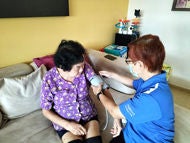What is - Psoriatic Arthritis
What happens to your joints in psoriatic arthritis?
Whom does psoriatic arthritis affect?
Symptoms of Psoriatic Arthritis
Psoriatic Arthritis - How to prevent
Psoriatic Arthritis - Causes and Risk Factors
Diagnosis of Psoriatic Arthritis
Treatment for Psoriatic Arthritis
Although there is no cure for PsA, most patients have their disease under control and lead meaningful lives. Sustained and increasing research is necessary.
A. Medication
B. Exercise
Once the inflammation is under control and you have less pain, it is important to rebuild the muscle and ligaments weakened by the arthritis. Exercise rebuilds muscle strength which can aid to stabilise the joints.
C. Surgery
Sometimes surgery is necessary to correct joint deformities or to replace a completely destroyed joint.
Psoriatic Arthritis - Other Information
Does psoriatic arthitis have complications?
Contributed by
The information provided is not intended as medical advice. Terms of use. Information provided by SingHealth.
Condition Treated At
Department
Rheumatology & Immunology
Department
Rheumatology
Department
General Medicine
Get to know our doctors at SingHealth Hospitals in Singapore.
Get to know our doctors at SingHealth Hospitals in Singapore. here.
Medicine
Our Medical Specialists
Related Conditions




















